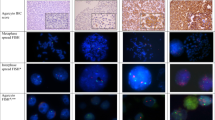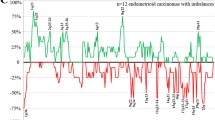Abstract
The origin of carcinosarcomas of the ovary and uterus has long been discussed. In this study, we used a molecular–genetic approach to elucidate the tumorigenesis of carcinosarcomas of these organs correlating our findings with the specific biphasic pattern of these tumors. We analyzed a series of 30 paraffin-embedded carcinosarcomas of the ovary and the uterus using comparative genomic hybridization (CGH) and fluorescence in-situ hybridization (FISH). In general, gains (85%) were observed more frequently, than losses (30%). Characteristic and frequent chromosomal amplification was observed on chromosome 8q and 20q (42 and 70%). FISH revealed c-myc (8q24.12) and ZNF217 (20q13.2) amplification in 78 and 87%. Amplification of ZNF217 was mostly seen in both tumor components, whereas amplification of c-myc was observed less often in the sarcomatous than in the carcinomatous tumor component. Analysis of the proliferation index using Ki67 immunohistochemistry revealed a strong or moderate expression in all cases, wherein the carcinomatous tumor component showed significantly a higher proliferation index compared to the sarcomatous tumor areas. Although our results are in agreement with a monoclonal origin of ovarian and uterine carcinosarcomas, the carcinomatous component seems to be the more aggressive part of the tumor. Furthermore, the observed patterns of genetic aberrations are highly similar to those of serous carcinomas. This is compatible with the current opinion that these neoplasms should be considered as metaplastic carcinomas.






Similar content being viewed by others
References
Abeln EC, Smit VT, Wessels JW, de Leeuw WJ, Cornelisse CJ, Fleuren GJ (1997) Molecular genetic evidence for the conversion hypothesis of the origin of malignant mixed Mullerian tumours. J Pathol 183:424–431
Auerbach HE, LiVolsi VA, Merino MJ (1988) Malignant mixed Mullerian tumors of the uterus. An immunohistochemical study. Int J Gynecol Pathol 7:123–130
Blom R, Guerrieri C, Stal O, Malmstrom H, Sullivan S, Simonsen E (1988) Malignant mixed Müllerian tumors of the uterus: A clinicopathologic, DNA flow cytometry, p53, and mdm-2 analysis of 44 cases. Gynecol Oncol 68:18–24
de Brito PA, Silverberg SG, Orenstein JM (1993) Carcinosarcoma (malignant mixed mullerian (mesodermal) tumor) of the female genital tract: immunohistochemical and ultrastructural analysis of 28 cases. Hum Pathol 24:132–142
Collins C, Rommens JM, Kowbell D (1998) Positional cloning of ZNF217 andNABC1: genes amplified at 20q13.2 and overexpression in breast carcinoma. Proc Natl Acad Sci USA 95:8703–8708
Chung MT, Mukai K, Teshima S, Kishi K, Shimosato Y (1988) Expression of various antigens by different components of uterine mixed Mullerian tumors. An immunohistochemical study. Acta Pathol Jpn 38:35–45
Costa MJ, Vogelsan J, Young LJ (1994) p53 gene mutation in female genital tract carcinosarcomas (malignant mixed Mullerian tumors): a clinicopathologic study of 74 cases. Mod Pathol 7:619–627
Costa MJ, Khan R, Judd R (1991) Carcinoma (malignant mixed mullerian [mesodermal] tumor) of the uterus and ovary. Correlation of clinical, pathologic, and immunohistochemical features in 29 cases. Arch Pathol Lab Med 115:583–590
Costa MJ, Walls J (1996) Epidermal growth factor receptor and c-erbB-2 oncoprotein expression in female genital tract carcinosarcomas (malignant mixed Mullerian tumors). Clinicopathologic study of 82 cases. Cancer 77:533–542
Diebold J, Mosinger K, Peiro G, Pannekamp U, Kaltz C, Lohrs U et al (2000) 20q13 and cyclin D1 in ovarian carcinomas. Analysis by fluorescence in situ hybridization. J Pathol 190:564–571
Emoto M, Iwasaki H, Ishiguro M, Kikuchi M, Horiuchi S, Kawarabayashi T et al (1999) Angiogenesis in carcinosarcomas of the uterus: differences in the microvessel density and expression of vascular endothelial growth factor between the epithelial and mesenchymal elements. Hum Pathol 30:1232–1241
Emoto M, Iwasaki H, Oshima K, Kikuchi M, Kaneko Y, Kawarabayashi T (1997) Characteristics of rhabdomyosarcoma cell lines derived from uterine carcinosarcomas. Virchows Arch 431:249–256
Emoto M, Iwasaki H, Kikuchi M, Ishiguro M, Kubota T, Kaneko J et al (1992) Two cell lines established from mixed mullerian tumors of the uterus. Morphologic, immunocytochemical, and cytogenetic analyses. Cancer 69:1759–1768
Fujii H, Yoshida M, Gong ZX, Matsumoto T, Hamano Y, Shirai T et al (2000) Frequent genetic heterogeneity in the clonal evolution of gynecological carcinosarcoma and its influence on phenotypic diversity. Cancer Res 60:114–120
Gallardo A, Matias-Guiu X, Lagarda H, Catasus L, Bussaglia E, Prat J et al (2002) Malignant mullerian mixed tumor arising from ovarian serous carcinoma: a clinicopathologic and molecular study of two cases. Int J Gynecol Pathol 21:268–272
Geisinger KR, Dabbs DJ, Marshall RB (1987) Malignant mixed Mullerian tumors. An ultrastructural and immunohistochemical analysis with histogenetic considerations. Cancer 59:1781–1790
George E, Manivel JC, Dehner LP, Wick MR (1991) Malignant mixed Mullerian tumors: an immunohistochemical study of 47 cases, with histogenetic considerations and clinical correlation. Hum Pathol 22:215–223
Gorai I, Doi C, Minaguchi H (1993) Establishment and characterization of carcinosarcoma cell line of the human uterus. Cancer 71:775–786
Gorai I, Yanagibashi T, Taki A, Udagawa K, Miyagi E, Minaguchi H et al (1997) Uterine carcinosarcoma is derived from a single stem cell: an in vitro study. Int J Cancer 72:821–827
Gorstein F, Anderson TL (1991) Malignant mixed mesodermal tumors: carcinoma, sarcoma, or both? Hum Pathol 22:207–209
Gunawan B, Baumhoer D, Schulten HJ, Emons G, Fuzesi L (2003) Polysomy 8 in three cases of homologous malignant mixed Mullerian tumors of the uterus. Anticancer Res 23:1379–1383
Haba R, Kobayashi S, Miki H, Hirakawa E, Mori S, Ishii Y et al (1993) Mixed mesodermal tumor of the ovary: immunohistochemical study with histogenetic consideration. Acta Pathol Jpn 43:696–701
Ishikawa S, Kaneko H, Sumida T, Sekiya M (1979) Ultrastructure of mesodermal mixed tumor of the uterus. Acta Pathol Jpn 29:801–809
Jeffers MD, Richmond JA, Macaulay EM (1995) Overexpression of the c-myc proto-oncogene occurs frequently in uterine sarcomas. Mod Pathol 8:701–704
Kounelis S, Jones MW, Papadaki H, Bakker A, Swalsky P, Finkelstein SD (1998) Carcinosarcomas (malignant mixed mullerian tumors) of the female genital tract: comparative molecular analysis of epithelial and mesenchymal components. Hum Pathol 29:82–87
Mayall F, Rutty K, Campbell F, Goddard H (1994) p53 immunostaining suggests that uterine carcinosarcomas are monoclonal. Histopathology 24:211–214
McCluggage WG (2002) Malignant biphasic uterine tumors: carcinosarcomas or metaplastic carcinomas? J Clin Pathol 55:321–325
McCluggage WG (2002) Uterine carcinosarcomas (malignant mixed Mullerian tumors) are metaplastic carcinomas. Int J Gynecol Cancer 12:687–690
Meis JM, Lawrence MD (1990) The immunohistochemical profile of malignant mixed mullerian tumor. Overlap with endometrial adenocarcinoma. Am J Clin Pathol 94:1–7
Micci F, Teixeira MR, Haugom L, Kristensen G, Abeler VM, Heim S (2004) Genomic aberrations in carcinomas of the uterine corpus. Genes Chromosomes Cancer 40:229–246
Nicotina PA, Ferlazzo G, Vicelli AM (1997) Proliferation indices and p53 immunocytochemistry in uterine mixed mullerian tumors. Histol Histopathol 12:967–972
Schulten HJ, Gunawan B, Enders C, Donhuijsen K, Emons G, Füzesi L (2004) Overrepresentation of 8q in carcinosarcomas and endometrial adenocarcinomas. Am J Clin Pathol 122:546–551
Silverberg SG, Major FJ, Blessing JA, Fetter B, Askin FB, Miller A et al (1990) Carcinosarcoma (malignant mixed mesodermal tumor) of the uterus. A Gynecologic Oncology Group pathologic study of 203 cases. Int J Gynecol Pathol 9:1–19
Simon R, Burger H, Brinkschmidt C, Bocker W, Hertle L, Terpe HJ (1998) Chromosomal aberrations associated with invasion in papillary superficial bladder cancer. J Pathol 185:345–351
Soong R, Knowles S, Hammond IG, Michael C, Iacopetta BJ (1999) p53 protein overexpression and gene mutation in mixed Mullerian tumors of the uterus. Cancer Detect Prev 23:8–12
Sreenan JJ, Hart WR (1995) Carcinosarcomas of the female genital tract. A pathologic study of 29 metastatic tumors: further evidence for the dominant role of the epithelial component and the conversion theory of histogenesis. Am J Surg Pathol 19:666–674
Thompson L, Chang B, Barsky SH (1996) Monoclonal origins of malignant mixed tumors (carcinosarcomas). Evidence for a divergent histogenesis. Am J Surg Pathol 20:277–285
Wada H, Enomoto T, Fujita M, Yoshino K, Nakashima R, Tsujimoto M et al (1997) Molecular evidence that most but not all carcinosarcomas of the uterus are combination tumors. Cancer Res 57:5379–5385
Yoshida Y, Kurokawa T, Fukuno N, Nishikawa Y, Kamitani N, Kotsuji F (2000) Markers of apoptosis and angiogenesis indicate that carcinomatous components play an important role in the malignant behavior of uterine carcinosarcoma. Hum Pathol 31:1448–1454
Acknowledgments
The authors thank Beate Luthardt for excellent technical assistance.
Author information
Authors and Affiliations
Corresponding author
Rights and permissions
About this article
Cite this article
Schipf, A., Mayr, D., Kirchner, T. et al. Molecular genetic aberrations of ovarian and uterine carcinosarcomas—a CGH and FISH study. Virchows Arch 452, 259–268 (2008). https://doi.org/10.1007/s00428-007-0557-6
Received:
Revised:
Accepted:
Published:
Issue Date:
DOI: https://doi.org/10.1007/s00428-007-0557-6




